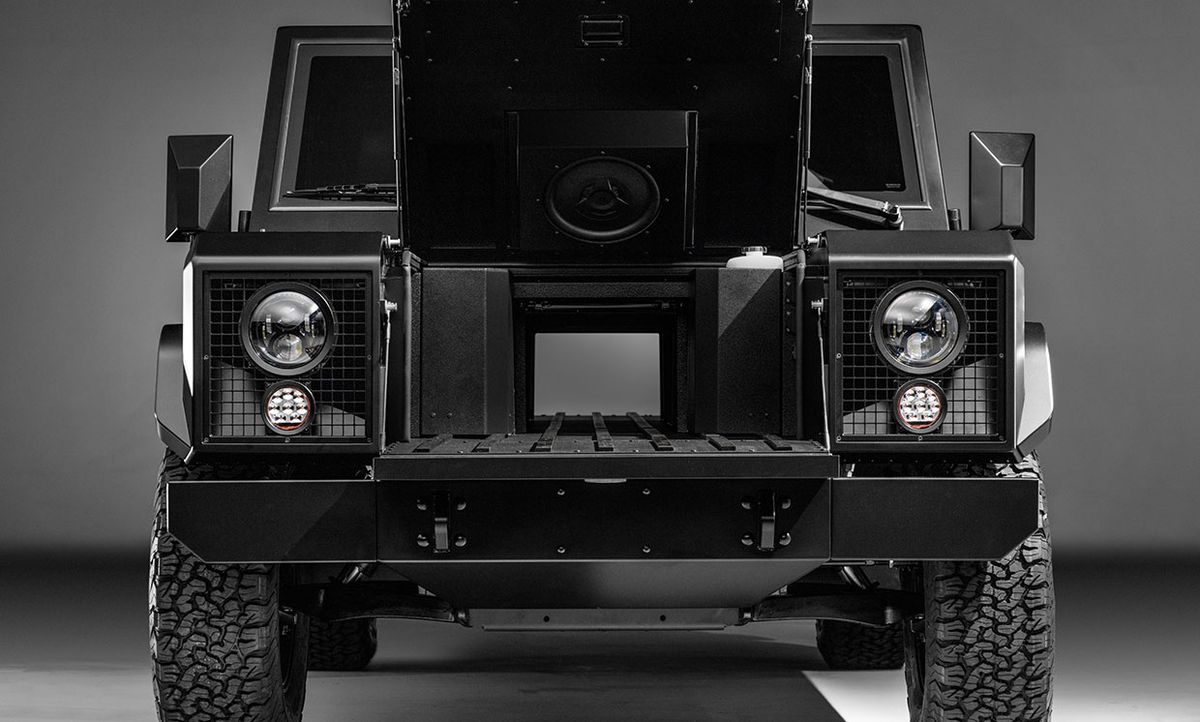A gasoline engine up front, a transmission in the middle, and a fuel tank in back: For decades, that’s the way most automobiles were designed.
Electricity has changed that equation. And the Bollinger B1 sport-utility and B2 pickup are among the new electric vehicles( EVs) that show car designers are taking full advantage of the freedoms afforded by electric propulsion.
Bollinger Motors, based in suburban Detroit, this week announced it has received U.S. patents for its clever Frunkgate and Passthrough features on its brawny US $125,000 electric SUV and pickup.
For the Frunkgate, picture a conventional, fold-down tailgate on a pickup, only up front. The Passthrough connects front and rear, via a passageway bored though the front firewall and the passenger compartment.

The result is unprecedented cargo-carrying versatility: The cargo beds of most “full-size” pickup trucks are just 1.8 meters (or 6 feet) long, with the longest beds limited to 2.4 m. But the Bollinger B2 can swallow cargo up to 4.9 meters long—lumber, ladders, poles, gutters, whatever—that extends from the truck’s blunt nose all the way to the back of its tailgate.
Drop the tailgate, and even longer items can fit aboard. And the only reason any of this is possible is because there’s no engine in the way, no need for an air-inhaling grille and radiator up front, and no transmission running along the vehicle’s spine.
“It’s a simple idea, but it transforms the truck,” said Robert Bollinger, the company’s founder. “And lo and behold, no one had patented the idea.”
Even the Bollinger B1 SUV can handle items up to 4 meters long, with its haul locked safely inside.

“I can’t do that in my Chevy pickup,” Bollinger said. “And if you’re in any SUV, and you’re passing Home Depot and need that 10-foot two-by-four, you can’t get it home.”
When Bollinger founded his company in 2015, the very idea of an electric pickup truck seemed a novelty. Bollinger earned a Carnegie Mellon degree in industrial and product design, made it big with a hair- and skin-care company, and then sold his Catskills farm to move to Detroit and follow his lifelong automotive dream.
Suddenly, electric pickups are the hottest thing in the electric game, with Tesla, Ford, Rivian, and General Motors’ Chevrolet and GMC Hummer brands among those racing to bring models to market. Bollinger is a relatively small player, but appears to be on track to beat them all to showrooms, with plans to build 1,000 copies of the B1 and B2 in 2021, and to grow from there.
Bollinger’s aluminum-bodied brutes send 614 horsepower and 668 pound-feet of torque to all four wheels, with a claimed 0 to 60 mph run in a sizzling 4.5 seconds.
But their main mission is as hardcore, Class 3 work vehicles, including the ability to carry a remarkable 2.3 metric tons of cargo. Their door and roof panels are also removable, as in a Jeep Wrangler, for fresh-air adventures. And their complex, pricey “portal axles,” currently found on just one other production passenger model—the $225,000 Mercedes-Benz G550 4x4 Squared—give the Bollingers an insane half a meter of adjustable ground clearance, allowing them to traverse any imaginable terrain, or wade through one-meter-deep water.

A little engineering ingenuity allows the Bollingers to squeeze more out of their electric layouts. Their massive 120 kilowatt-hour battery packs let the vehicles operate as all-day mobile generators and workshops on construction sites or farms. That includes four powerful, 30-amp electric outlets in their “frunk”—the portmanteau for the underhood storage area in models like the rear-engined, Porsche 911 sports car, or Teslas.
That 244-liter frunk can hold electric saws and other power tools, while the Frunkgate can fold down to double as a workbench. An onboard power inverter reduces the 360-volt main system to 240 volts for those robust outlets at the front and rear; to household voltage for interior hookups to laptops and other devices; and to 12 volts to power traditional gauges and accessories.
A Bollinger competitor, Rivian—whose major backers include Ford and Amazon—is also advancing the trend in versatile, efficient EV design with its own “Gear Tunnel,” which runs side-to-side rather than front-to-back. In the Rivian R1T truck and R1S SUV models, that feature allows for an optional “camp kitchen,” which includes a two-burner cooktop, working sink, and storage that slides out from the vehicles’ sides.
Another perk: The Rivian’s four, individual electric wheel motors let it perform a unique “Tank Turn”: The truck can rotate in place, by spinning wheels on each side of the truck in opposite directions, for easy maneuvering in tight quarters—or just spraying mud in a video-friendly fashion.
So what took manufacturers so long to debut such novel ideas in EV design?
Experts say that older generations of EVs were typically retrofits of existing car platforms, which gave designers literally no room to experiment. Since those platforms were never designed to carry batteries beyond a conventional 12-volt lead-acid unit, designers were forced to cram propulsion batteries in wherever they could, especially in trunks and hatches. The resulting EVs and even hybrids actually had less cargo or passenger space than fossil-fueled versions—a turn-off for potential buyers.
In contrast, the latest EVs are blank-sheet creations, envisioned as electric cars from the outset. Their architectures integrate “skateboard” platforms that package lithium-ion batteries entirely below the floor, which not only improves passenger and cargo space, but boosts handling by lowering a vehicle’s center of gravity. Reducing the size, weight, and cost of those batteries remains a major challenge. But designers are now free to tinker with all the space above—including punching holes in a truck from nose to tail.
“If you start from the ground up, you make a much more efficient and wonderful vehicle,” Bollinger said.
Lawrence Ulrich is an award-winning auto writer and former chief auto critic at The New York Times and The Detroit Free Press.



